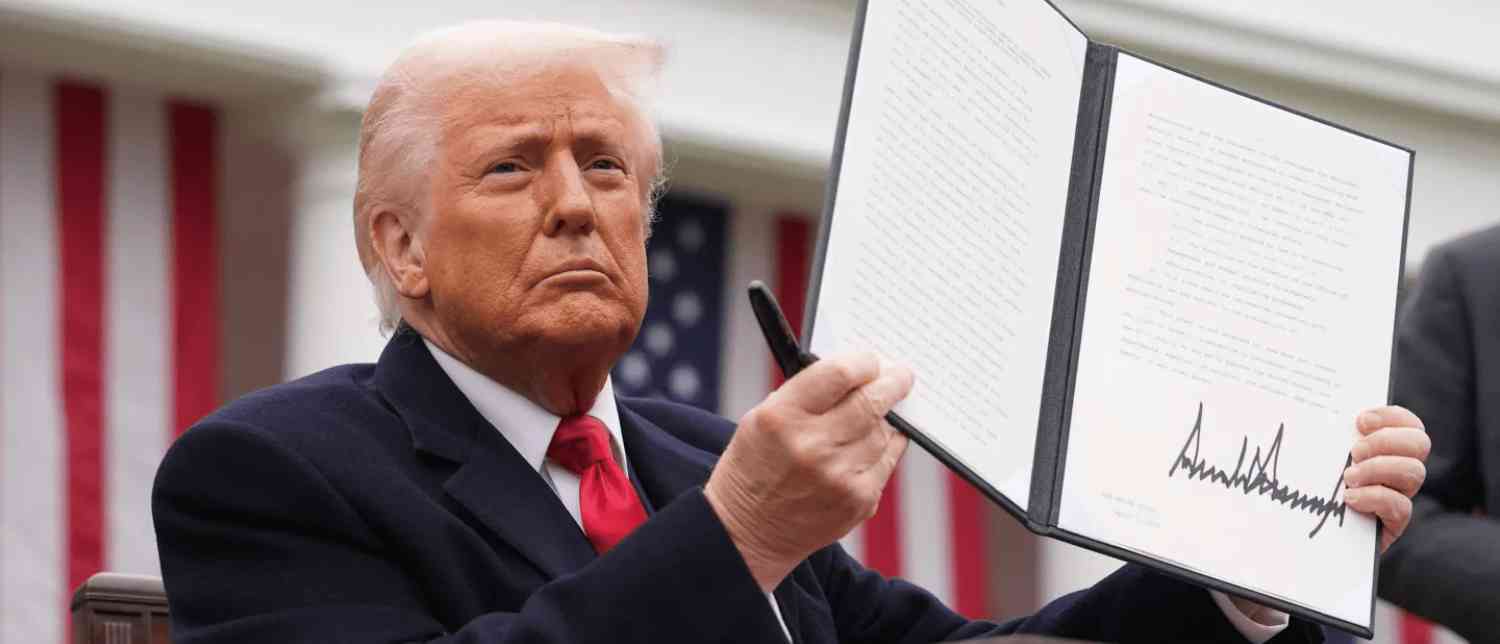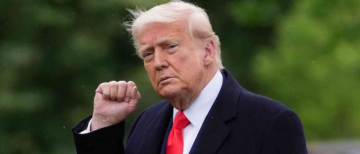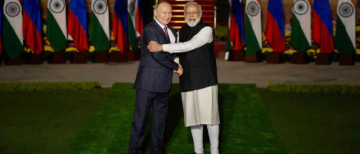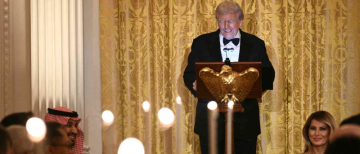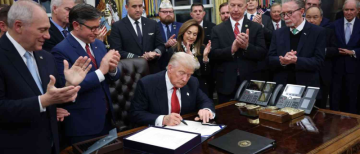A major blow has struck one of Donald Trump’s most aggressive economic strategies. A federal appeals court has ruled that former U.S. President Donald Trump’s sweeping global tariffs were “mostly illegal,” raising questions about the scope of presidential authority in trade and casting uncertainty over billions of dollars in tariff revenues.
While the tariffs remain in effect for now, the ruling has opened a high-stakes battle over whether Trump overstepped his legal authority — a dispute that could ultimately land in the U.S. Supreme Court.

Background: Trump’s “Liberation Day” Tariffs
On April 2, in what he called “Liberation Day,” Trump imposed sweeping tariffs on nearly every U.S. trading partner. The measures included:
-
A baseline 10% tariff on almost all imported goods.
-
“Reciprocal” tariffs of up to 50% on countries with which the U.S. ran a trade deficit.
-
Additional penalties on countries like India, which faced a 50% tariff plus a 25% penalty for purchasing Russian energy.
These tariffs came on top of earlier levies Trump had imposed on China, Mexico, and Canada, citing national emergencies linked to drug trafficking and illegal immigration.
Some nations negotiated deals to avoid the harshest penalties. The U.K., Japan, and the European Union agreed to new trade arrangements, while others like Laos and Algeria were hit with tariffs of 40% and 30%, respectively.
Trump argued that the U.S. trade deficit was a national emergency, using this justification to invoke the International Emergency Economic Powers Act (IEEPA) of 1977 — a law historically used for financial sanctions and asset freezes, not broad import taxes.
What the Court Ruled
The U.S. Court of Appeals for the Federal Circuit, in a 7–4 decision, found that Trump had exceeded his authority under IEEPA.
Key points from the ruling include:
-
IEEPA does not authorize tariffs: The judges concluded that while the law gives the president authority to regulate certain economic transactions during emergencies, it does not explicitly grant the power to impose tariffs, duties, or taxes.
-
Congress never intended unlimited tariff powers: The court emphasized that the text and structure of IEEPA make it unlikely that lawmakers meant to give the president unlimited authority over tariffs.
-
Tariffs remain in effect temporarily: Although the tariffs were declared illegal, the appeals court allowed them to stay in place until October 14, giving the administration time to appeal to the Supreme Court.
-
Earlier ruling upheld: The decision largely reaffirmed a May ruling by the U.S. Court of International Trade in New York, which combined lawsuits filed by several businesses and 12 U.S. states challenging the legality of Trump’s tariffs.
Notably, the ruling does not affect Trump’s other tariffs imposed under different laws — such as Section 232 of the Trade Expansion Act of 1962 (steel, aluminum, autos) and the China-specific tariffs under his first-term trade war.
Trump’s Response: “Total Disaster” if Tariffs Fall
Unsurprisingly, Trump blasted the ruling as politically motivated and warned of dire consequences if the tariffs were struck down.
On his Truth Social platform, he wrote:
-
“ALL TARIFFS ARE STILL IN EFFECT!”
-
“Today, a Highly Partisan Appeals Court incorrectly said that our Tariffs should be removed, but they know the United States of America will win in the end.”
-
“If these tariffs ever went away, it would be a total disaster for the Country. It would make us financially weak, and we have to be strong.”
-
“If allowed to stand, this Decision would literally destroy the United States of America.”
Trump defended tariffs as the “best tool” to support U.S. workers and manufacturers and vowed to take the case to the Supreme Court.
White House spokesman Kush Desai also maintained that Trump acted lawfully, while Attorney General Pam Bondi accused the judges of interfering with presidential foreign policy powers.
Financial and Economic Stakes
The tariffs have generated $159 billion in revenue by July — more than double what was collected at the same time the previous year. This revenue has become a key source of government funds.
If the tariffs were ultimately struck down:
-
The U.S. Treasury could be forced to refund billions of dollars in duties already collected.
-
The Justice Department warned this could trigger “financial ruin” for the country.
-
Businesses could face new uncertainty in pricing, supply chains, and long-term contracts.
-
Trump could lose a pillar of his trade negotiating strategy, which relied heavily on tariff threats to pressure foreign governments into new trade deals.
Ashley Akers, a former Justice Department lawyer, noted:
“While existing trade deals may not automatically unravel, the administration could lose a pillar of its negotiating strategy, which may embolden foreign governments to resist future demands, delay implementation of prior commitments, or even seek to renegotiate terms.”
Why IEEPA Matters: The Legal Debate
At the heart of the dispute is whether the 1977 IEEPA law allows a president to impose broad tariffs.
Historically, IEEPA has been used for:
-
Blocking terrorist financing networks (George W. Bush after 9/11).
-
Sanctioning foreign hackers (Barack Obama in 2015).
-
Targeting Venezuela’s state-owned oil company, reimposing sanctions on Iran, and penalizing International Criminal Court officials (Trump himself).
However, no president before Trump had used IEEPA for blanket import taxes. Legal experts argue that Congress has gradually ceded tariff powers to the executive branch, but the Constitution reserves taxing authority to lawmakers.
The dissenting judges in the appeals court disagreed with the majority, arguing that delegating some tariff powers to the president under IEEPA was not unconstitutional. This dissent could give Trump a possible legal path at the Supreme Court.
What Happens Next?
The case is now poised for a potential showdown at the U.S. Supreme Court. The administration has until October 14 to appeal.
If the Supreme Court takes the case, it could redefine the balance of power between Congress and the president on trade matters — an issue with broad implications beyond Trump’s tariffs.
Meanwhile, Trump still has other legal tools, though far more limited:
-
Trade Act of 1974: Allows tariffs up to 15% for a maximum of 150 days against countries with which the U.S. has trade deficits.
-
Section 232 of the Trade Expansion Act (1962): Allows tariffs for national security reasons, but requires a formal Commerce Department investigation.
Neither option gives the sweeping authority Trump claimed under IEEPA.
Why It Matters Globally
The ruling has left foreign governments, global markets, and U.S. businesses in limbo. For countries like India, which faced punitive tariffs, the uncertainty complicates ongoing trade talks.
If Trump loses his ability to impose such tariffs unilaterally, foreign governments may feel emboldened to resist future U.S. demands, delay commitments, or seek to renegotiate trade deals.
For American businesses, the uncertainty has already meant volatile markets, higher costs, and disrupted supply chains. The stakes are especially high for farmers and manufacturers who rely on both imports and exports.
What's Next
The federal court ruling against Trump’s tariffs marks one of the most significant legal challenges to his trade agenda, with consequences that stretch beyond tariffs themselves.
At issue is not just the future of billions in revenue or the structure of U.S. trade policy, but the fundamental question of how much unilateral power a president can wield over the economy in the name of a “national emergency.”
As Trump vows to take the fight to the Supreme Court, businesses, foreign governments, and ordinary Americans will be watching closely. The outcome could shape the direction of U.S. trade policy — and presidential power — for years to come.
With inputs from agencies
Image Source: Multiple agencies
© Copyright 2025. All Rights Reserved. Powered by Vygr Media.

